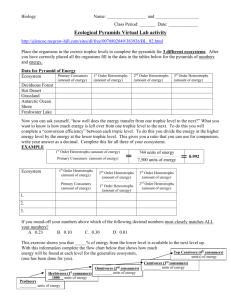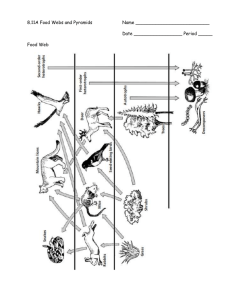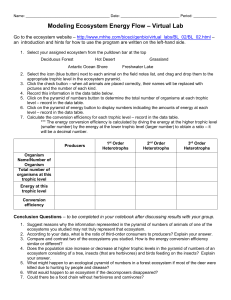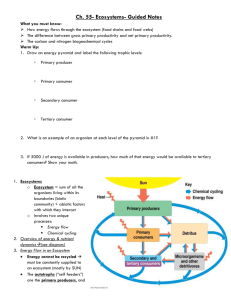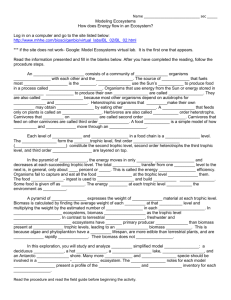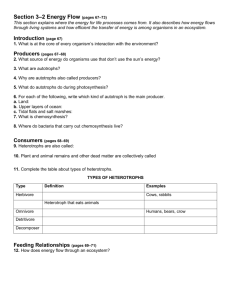Ecology Pyramid Simulation Ecological Pyramids Online
advertisement
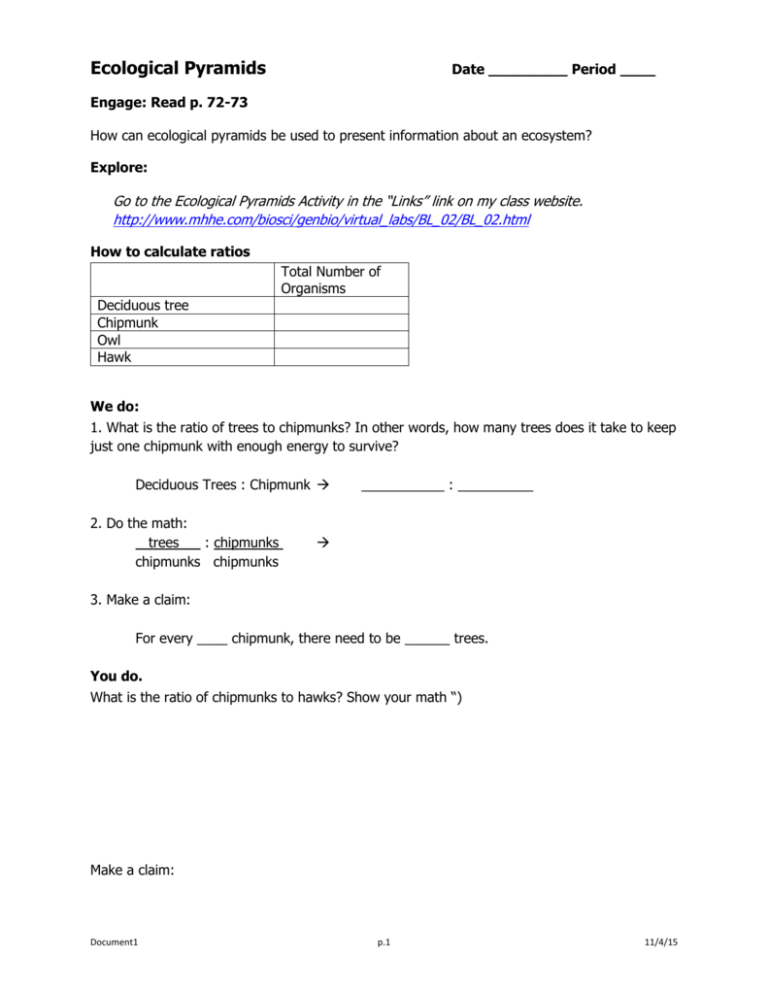
Ecological Pyramids Date _________ Period ____ Engage: Read p. 72-73 How can ecological pyramids be used to present information about an ecosystem? Explore: Go to the Ecological Pyramids Activity in the “Links” link on my class website. http://www.mhhe.com/biosci/genbio/virtual_labs/BL_02/BL_02.html How to calculate ratios Total Number of Organisms Deciduous tree Chipmunk Owl Hawk We do: 1. What is the ratio of trees to chipmunks? In other words, how many trees does it take to keep just one chipmunk with enough energy to survive? Deciduous Trees : Chipmunk 2. Do the math: trees : chipmunks chipmunks chipmunks ___________ : __________ 3. Make a claim: For every ____ chipmunk, there need to be ______ trees. You do. What is the ratio of chipmunks to hawks? Show your math “) Make a claim: Document1 p.1 11/4/15 Ecological Pyramids (continued) Complete the calculations in your science notebook. Be sure to label which ecosystem, total numbers and ratio calculations Explore/Elaborate Full Food webs 1. Fill in the entire Deciduous Forest pyramid by clicking and dragging each organism into the appropriate trophic level. a. Click “Check” to check your answers. b. Click “Pyramid of Numbers” to see the total number of organisms at each trophic level. c. Use the number totals at each level to show the ratio of producers to 1st order heterotrophs. How many producers for every one 1st order heterotroph? Show your work! 2. Click on the triangle next to Deciduous Forest Ecosystem and switch to Hot Desert Ecosystem. a. Follow the same procedures as in step 1 to find the total number of organisms at each trophic level in the desert. b. What is the ratio of 1st order heterotrophs to 2nd order heterotrophs? How many 1st order heterotrophs for every one 2nd order heterotroph? Show your work! 3. Complete the Pyramid of Numbers in the Grassland Ecosystem. What is the ratio of 2nd order heterotrophs to 3rd order heterotrophs? How many 2nd order heterotrophs for every one 3rd order heterotroph? Show your work! Document1 p.2 11/4/15 Elaborate/ Explain 1. Why are there fewer organisms at each level of the Pyramid of Numbers than in the levels below? 2. Fill in the pyramid of the Antarctic Ocean Ecosystem and click on “Pyramid of energy” to show how much food energy is stored at each trophic level. Calculate the percent of energy gained at each level by dividing the energy at that level by the energy at the level below it and multiplying by 100. Round off answers to the closest whole number. Show your work! a. 1st order heterotrophs: 784 ÷ 8,006 x 100 = 10% b. 2nd order heterotrophs: ________________________________________ c. 3rd order heterotrophs: ________________________________________ 3. Follow the same procedures as in step 5 to calculate the percent of energy gained at each level in the Freshwater Lake Ecosystem. Show your work! a. 1st order heterotrophs: ________________________________________ b. 2nd order heterotrophs: ________________________________________ c. 3rd order heterotrophs: ________________________________________ 4. Why do organisms only get about 10% of the energy from the trophic level below them? 5. Constraints are things that limit how much you can do in a scientific investigation. What do you think would be some constraints in gathering the information for ecological pyramids like these? 6. What would happen to an ecosystem if all the producers died off? Explain your answer. 7. Apply what you’ve learned about interdependence to explain how wolf and deer populations in a forest ecosystem depend on each other. Document1 p.3 11/4/15

